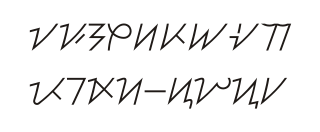Related Research Articles

The Bisayan languages or the Visayan languages are a subgroup of the Austronesian languages spoken in the Philippines. They are most closely related to Tagalog and the Bikol languages, all of which are part of the Central Philippine languages. Most Bisayan languages are spoken in the whole Visayas section of the country, but they are also spoken in the southern part of the Bicol Region, islands south of Luzon, such as those that make up Romblon, most of the areas of Mindanao and the province of Sulu located southwest of Mindanao. Some residents of Metro Manila also speak one of the Bisayan languages.
The Central Philippine languages are the most geographically widespread demonstrated group of languages in the Philippines, being spoken in southern Luzon, Visayas, Mindanao, and Sulu. They are also the most populous, including Tagalog, Bikol, and the major Visayan languages Cebuano, Hiligaynon, Waray, Kinaray-a, and Tausug, with some forty languages all together.
Ratagnon is a regional language spoken by the Ratagnon people, an indigenous group from Occidental Mindoro. It is a part of the Bisayan language family and is closely related to other Philippine languages. Its speakers are shifting to Tagalog, and it is nearly extinct.

Mangyan is the generic name for the eight indigenous groups found on the island of Mindoro, southwest of the island of Luzon, the Philippines, each with its own tribal name, language, and customs. The total population may be around 280,000, but official statistics are difficult to determine under the conditions of remote areas, reclusive tribal groups and some having little if any outside world contact.

The Philippine languages are a proposed group by R. David Paul Zorc (1986) and Robert Blust that include all the languages of the Philippines and northern Sulawesi—except Sama–Bajaw and a few languages of Palawan—and form a subfamily of Austronesian languages. Although the Philippines is near the center of Austronesian expansion from Formosa, there is little linguistic diversity among the approximately 150 Philippine languages, suggesting that earlier diversity has been erased by the spread of the ancestor of the modern Philippine languages.
The Buhid language is a language spoken by Mangyans in the island of Mindoro, Philippines. It is divided into eastern and western dialects.
The Tadyawan language is a language spoken by Mangyans in the southern Lake Naujan in Oriental Mindoro, Philippines.
Hanunoo, or Hanunó'o, is a language spoken by Mangyans in the island of Mindoro, Philippines.
The Alangan language is a language spoken by Mangyans in the province of Mindoro in the Philippines.
The Iraya language is a language spoken by Mangyans on the island of Mindoro in the Philippines. Zorc (1974) places the Iraya language within the North Mangyan group of Malayo-Polynesian languages, though Lobel (2013) notes that it shows "considerable differences" to Tadyawan and Alangan, the other languages in this group. There are 6,000 to 8,000 Iraya speakers, and that number is growing. The language status of Iraya is developing, meaning that this language is being put to use in a strong and healthy manner by its speakers, and it also has its own writing system.
The Kalamian languages are a small cluster of languages spoken in the Philippines: Calamian Tagbanwa and Agutaynen. Other languages called Tagbanwa, the Aborlan Tagbanwa language and Central Tagbanwa language are members of the Palawanic languages.
The Northern Mindoro languages are one of two small clusters of languages spoken by the Mangyan people of Mindoro Island in the Philippines.
The Mindanao or Southern Philippine languages are an obsolete proposal for a subgroup of the Austronesian languages comprising the Danao languages, the Manobo languages and Subanon, all of which are spoken in Mindanao, Philippines.
The Gorontalo–Mongondow languages are a group of Austronesian languages spoken in northern Sulawesi, Indonesia.
The Palawanic languages are a subgroup in the Greater Central Philippine-family spoken on the island of Palawan and nearby islets.
The Greater Central Philippine languages are a proposed subgroup of the Austronesian language family. They are spoken in the central and southern parts of the Philippines, and in northern Sulawesi. This subgroup was first proposed by Robert Blust (1991) based on lexical and phonological evidence, and is accepted by most specialists in the field.

Hanunoo, also rendered Hanunó'o, is one of the scripts indigenous to the Philippines and is used by the Mangyan peoples of southern Mindoro to write the Hanunó'o language.
Molbog is an Austronesian language spoken in the Philippines and Sabah, Malaysia. Majority of speakers are concentrated at the southernmost tip of the Philippine province of Palawan, specifically the municipalities of Bataraza and Balabac. Both municipalities are considered as bastions for environmental conservation in the province. The majority of Molbog speakers are Muslims.
Old Tagalog also known as Old Filipino, is the earliest form of the Tagalog language during the Classical period. It is the primary language of pre-colonial Tondo, Namayan and Maynila. The language originated from the Proto-Philippine language and evolved to Classical Tagalog, which was the basis for Modern Tagalog. Old Tagalog uses the Tagalog script or Baybayin, one of the scripts indigenous to the Philippines.
The Proto-Philippine language is a reconstructed ancestral proto-language of the Philippine languages, a proposed subgroup of the Austronesian languages which includes all languages within the Philippines as well as those within the northern portions of Sulawesi in Indonesia. Proto-Philippine is not directly attested to in any written work, but linguistic reconstruction by the comparative method has found regular similarities among languages that cannot be explained by coincidence or word-borrowing.
References
- ↑ Zorc, R. (1974). Internal and External Relationships of the Mangyan Languages. Oceanic Linguistics, 13(1/2), 561-600.
- ↑ Blust, Robert (1991). "The Greater Central Philippines hypothesis". Oceanic Linguistics. 30 (2): 73–129. doi:10.2307/3623084. JSTOR 3623084.